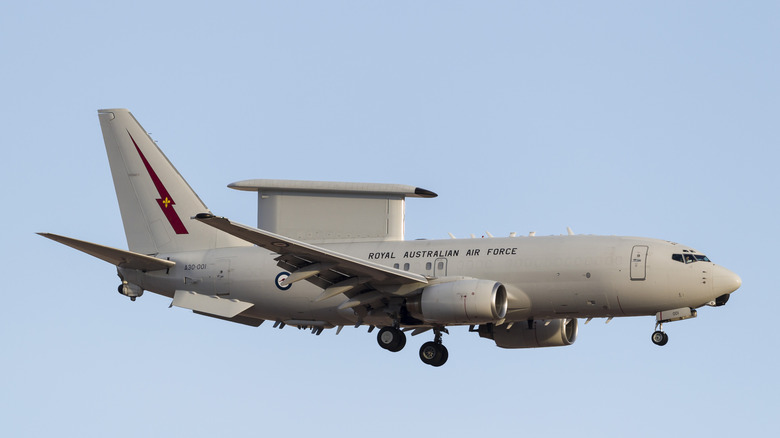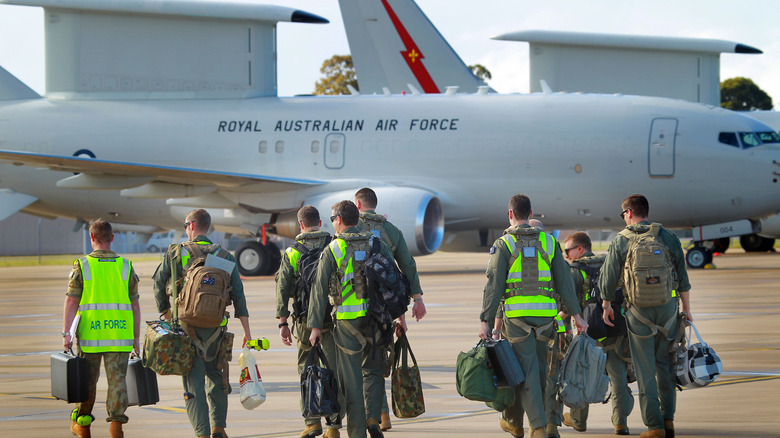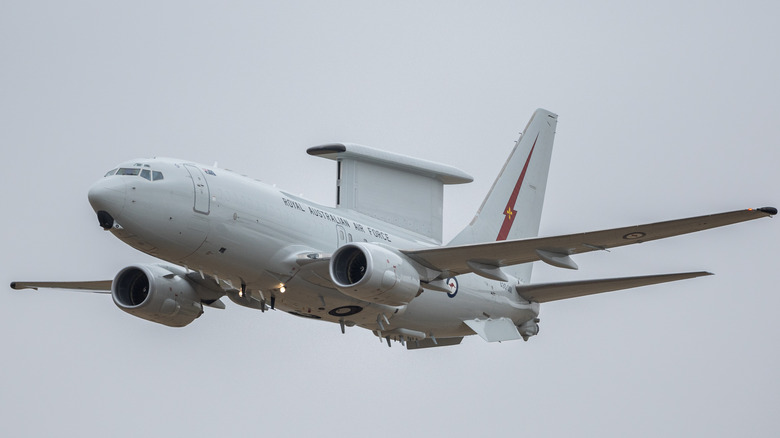This Boeing 737 Looks Super Strange, But Could Serve An Important Role In Defense
When the U.S. struck a $2.56 billion deal to purchase two converted Boeing 737s sporting a bizarre-looking 'top hat' radar system, many were skeptical. According to supporters of the deal, the U.S. might not have had much choice, as the country's airborne surveillance capabilities depend on its aging fleet of Boeing E-3 Sentrys. Debuting in 1977, the modified Boeing 707 is one of the oldest American military airplanes still in service. Equipped with a rotating radar dome that conducts surface-level surveillance up through the stratosphere, U.S. forces have depended on the Sentry to identify and track airborne enemy targets for nearly 50 years.
In recent years, however, American generals have grown concerned over the E-3's ability to track the next generation of advanced stealth aircraft, like the Chinese J-20 fighter jet. In 2022, for example, U.S. Pacific Air Forces General Kenneth Wilsbach remarked that the E-3's AWACS systems "aren't really capable in the twenty-first century." While U.S. generals have unsuccessfully tried to transition from the Sentry since 2001, rising global stealth capabilities and ongoing availability issues have underscored the lag in America's air surveillance infrastructure.
With NATO planning to phase out the E-3 by 2035 and the Air Force urgently needing a modern replacement, the Pentagon shifted focus to Boeing's E-7 Wedgetail, an Airborne Early Warning & Control (AEWC) aircraft developed for Australia's Royal Air Force, to fill the void in 2024. A derivative of the company's Next-Generation 737, the Wedgetail is distinguished by the radar system atop its fuselage resembling a dorsal fin. Just a year later, however, a debate has erupted between the Pentagon and U.S. lawmakers concerning the program, placing the future of the U.S.'s surveillance infrastructure up in the air.
The billion dollar planes
In the strange-looking Wedgetail, the United States hopes to find a ready-made airborne surveillance solution with supreme battle control and command functions to coordinate air, ground, and sea forces. Delivering long-range surveillance radar, its next-generation multi-role electronically scanned array (MESA) sensors provide 360-degree domain-awareness capabilities. Responsible for its distinctive dorsal look, this Northrop Grumman-manufactured MESA system utilizes advanced signal processing, high-power amplifiers, and scheduling algorithms technology to provide a highly customizable long-range radar system. According to Boeing, this top hat radar enables its modified 737 to achieve more than 4 million square kilometers of coverage during missions. Add tactical communications systems and advanced electronic warfare capabilities, and the Wedgetail could prove valuable as a central communications node while delivering 'first to detect, first to engage' capabilities.
Prior to the 2024 U.S. development deal, the aircraft played a central role in several U.S.-allied air forces. As of today, the list of U.S.-allied military forces deploying E-7 includes Australia, Turkey, the United Kingdom, and South Korea. NATO, for its part, struck a deal to replace its fleet of aging E-3s with the Wedgetail in 2023. Since then, the alliance has committed to purchasing 14 of the aircraft.
According to Boeing's press release following the U.S.'s August 2024 deal, the first of two prototypes would be delivered in 2028. While the initial costs of the prototypes were estimated at $588 million per aircraft, Boeing confirmed that the deal included the lifecycle development, training, and support functions. Under this deal, the U.S. would purchase 26 Wedgetails as it scaled its retirement of the E-3 AWACS. In the meantime, the Air Force is slated to continue its worldwide operation of the Boeing E-3.
Future outlook
Despite these advancements, some leading members of the Pentagon determined the program untenable, and the new administration added the E-7 to the list of roughly 340 aircraft on the budgetary chopping block. A major issue was ballooning costs, as a GAO report estimated that the price of developing the two aircraft would shoot to $3.56 billion, a near 33% increase. Senior military officials reported in June 2025 that this included a nearly $140 million increase in the cost of each airplane alone, further stoking concerns over the program's long-term costs. Survivability was also a major concern for the Pentagon, with DoD head Pete Hegseth singling out the dorsaled Boeing 737 as an aircraft that was "not survivable in the modern battlefield" during a June 2025 congressional hearing. For critics of the E-7, the Russo-Ukrainian theater is often a poster child for the ineffectiveness of such systems, where several AWCS planes have been downed or attacked since 2022.
Instead of the E-7, the Pentagon pushed Congress to invest in a space-based satellite program. This request formed part of a broader space-based defense push, headlined by the Golden Dome missile defense system. As a stopgap measure, the Pentagon proposed the procurement of additional E-2 Hawkeyes. While critics remain skeptical of the DoD's ability to deliver such a system quickly, others cite its game-changing potential as warranting the investment. Congress, for its part, rejected the Pentagon's change of heart, instead approving a budget that included $847 million for the prototyping program in 2026. Whether this commitment to the E-7 extends beyond its two prototypes, however, remains to be seen. NATO, meanwhile, is reportedly reconsidering its purchase of 14 Wedgetails amidst the Pentagon's wavering support for the aircraft.


